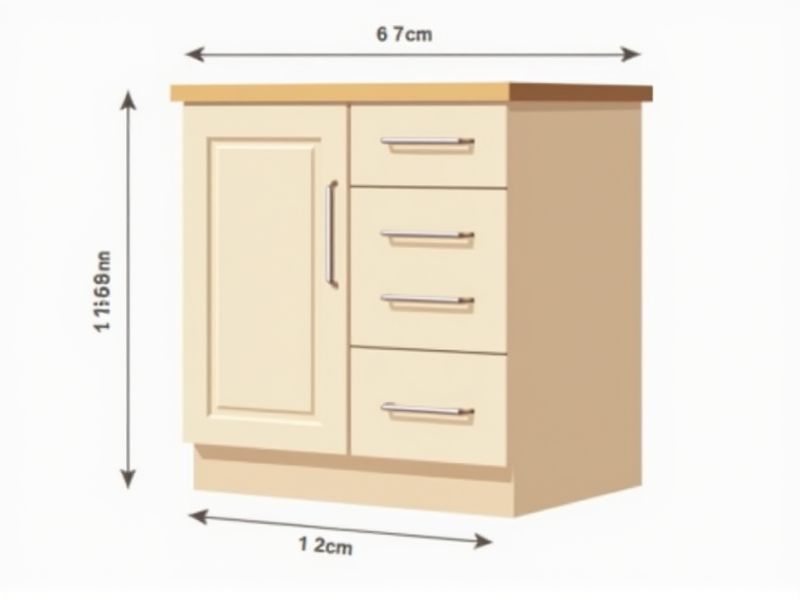
Understanding standard kitchen cabinet dimensions can help you plan an efficient and functional kitchen layout. Typically, base cabinets are 24 inches deep and 34.5 inches tall, while wall cabinets are 12 inches deep and available in heights of 30, 36, or 42 inches to accommodate ceiling height. Standard cabinet widths generally start at 9 inches and increase in 3-inch increments up to 48 inches, allowing flexibility for appliances and storage needs. Knowing these measurements makes it easier to design your kitchen or communicate your requirements to professionals.
Base Cabinet Height
The standard height for base kitchen cabinets is typically 34.5 inches, which allows for a comfortable working surface when combined with a countertop thickness of 1.5 inches, resulting in an overall height of 36 inches. This height is designed to accommodate a range of users and provides ergonomic benefits, reducing strain during meal preparation. When planning your kitchen layout, consider that this standard can also be customized based on individual needs, with heights ranging from 30 to 42 inches available. Proper installation of base cabinets at the right height ensures optimal functionality and aesthetics in your kitchen space.
Base Cabinet Depth
The standard depth for base kitchen cabinets is typically 24 inches, providing ample space for countertop overhang and appliances. This depth accommodates common kitchen tasks and ensures efficient workflow. Consider how your cabinet depth interacts with other elements, such as a 15-inch deep sink or 12-inch deep refrigerator, to maintain a cohesive design. You might also explore variations, such as deeper cabinets up to 30 inches, which offer increased storage but require careful consideration of space and usability.
Wall Cabinet Height
The standard height for wall cabinets in a kitchen typically ranges from 30 to 42 inches above the countertop. This height ensures easy access while maximizing storage space for your kitchen essentials. Ideally, wall cabinets should be installed 18 inches above the countertop to provide adequate clearance for typical kitchen appliances and workspace. When planning your kitchen layout, consider the ceiling height, as taller ceilings can accommodate wall cabinets up to 54 inches, offering even more storage solutions.
Wall Cabinet Depth
A standard wall cabinet depth typically measures 12 inches, providing ample space for storing kitchen essentials without protruding excessively into the room. This depth strikes a balance between maximizing vertical storage while maintaining an open and airy kitchen feel. For homeowners, installing cabinets with a depth ranging from 12 to 15 inches can accommodate larger items and offer versatility for various storage needs. When planning your kitchen layout, ensure that the height of wall cabinets aligns with your overall kitchen design for optimal functionality and aesthetic appeal.
Countertop Overhang
Countertop overhang is essential for kitchen cabinet design, typically ranging from 1 to 1.5 inches for optimal aesthetic and functional balance. This overhang not only enhances the visual appeal of your cabinets but also provides a comfortable space for seating, especially in island configurations. Properly designed overhang encourages ergonomic use and can prevent spills and splashes, protecting the cabinetry below. For your kitchen, consider the material and thickness of the countertop, as these factors influence the durability and support of the overhang.
Toe Kick Height
The standard toe kick height for kitchen cabinets typically measures 3 to 4 inches, creating a comfortable space for your feet while standing. This height not only enhances ergonomic access to cabinetry but also contributes to a clean aesthetic by providing a finished look. Designing your kitchen with a toe kick that maintains this height can improve comfort during culinary tasks and allow for easier cleaning beneath cabinets. Many manufacturers recommend keeping the toe kick depth at around 1.5 inches to ensure sufficient clearance and functionality.
Drawer Depth
The standard kitchen cabinet drawer depth typically measures 24 inches, which accommodates most kitchen storage needs. For optimal functionality, aim for a minimum drawer depth of 18 inches to ensure sufficient space for larger pots and pans. You might also consider drawers with varying depths; a shallower top drawer, around 6 to 8 inches, is ideal for utensils and smaller items. Custom options are available, allowing you to tailor drawer depths to fit specific kitchen layouts or personal storage requirements, enhancing both organization and accessibility.
Upper Cabinet Spacing
The standard spacing for upper kitchen cabinets typically ranges from 18 to 24 inches above the countertop, ensuring optimal functionality and accessibility. For optimal efficiency, maximizing storage means placing cabinets 54 to 60 inches above the floor, aligning them with average user height. In modern kitchen designs, it is common to maintain 12-inch deep cabinets to accommodate various kitchen appliances. When planning your kitchen layout, consider these measurements to create a space that enhances both storage and usability.
Corner Cabinet Dimensions
Corner cabinet dimensions typically range from 30 to 36 inches in height and 24 to 36 inches in depth, accommodating various kitchen layouts. The width often spans 36 inches, ideal for maximizing storage in the often underutilized corner space. It's essential to consider the corner radius, usually between 12 to 18 inches, ensuring easy access without compromising accessibility. Proper installation with a Lazy Susan or pull-out shelves can enhance your kitchen's functionality, making these dimensions crucial for optimizing your kitchen design.
Island Clearance Space
The standard recommendation for kitchen island clearance space is 42 to 48 inches, ensuring ample room for movement and accessibility. This distance allows for safe passage around the island while accommodating multiple users, optimizing workflow in the kitchen. When planning your kitchen layout, consider incorporating at least 60 inches of clearance when the island includes seating, providing additional comfort for diners. Adhering to these guidelines enhances both functionality and aesthetics in your kitchen design.
